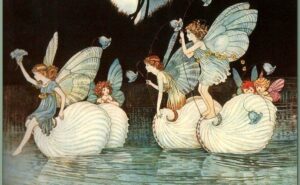Fairy Fashions: The Three Rules September 1, 2022
Author: Beach Combing | in : Contemporary, Medieval, Modern , trackbackSupernatural fashions come and go. One generation ghosts are hopping around in shrouds, then they are carrying their heads under their arms, next we have clanking chains… Fairy fashions, though, as I argue on the latest episode of Boggart and Banshee, are surprisingly constant. I offer here my three fairy fashion rules.
Rule 1: ‘Uniform but not uniforms’. Fairies, when seen in groups, tend to wear similar, though not identical clothes. Ten fairy hunters in the Cheviots, say, will have the same colours and the same style: often green and red. They will have the same colour horses and the same weapons. This was more striking in medieval and early modern societies where similar clothes of this type were rare. But it is interesting the way uniformity continues through into contemporary accounts. This perhaps speaks to fairies’ hive nature?
Rule 2: ‘Shop at Harrods’. Fairy clothes are luscious. They are made of expensive fabrics. Find the word ‘silk’ in a middle Welsh tale and you know you are in the presence of fairies. If a fairy is wearing leather, it will be Cordovan not vinyl. Arrows are flighted with peacock feathers. Sword hilts have ivory. There are the rich mix of colours (see rule 1) which in agricultural societies were, themselves, a statement of wealth. ‘The good people’ may not always be good, but they exude, in traditional folklore and experiences, affluence.
Rule 3: ‘Go Retro’. Fairies don’t like modern dress. In fact, they wear the clothes of seventy or sometimes seven hundred years before. This is not just a question of digital-era humans seeing fairies with faux-medieval togs. From the 1600s we have references to fairies wearing old-fashioned dress. Chris Woodyard (the ‘Banshee’ of the podcast) points to the use of ‘quaint’ to describe fairy clothes in Sir Orfeo, c. 1300: though, as Chris acknowledges, the word is difficult to interpret there.
Chris and I predictably disagree about some of these points. She does not think that rule 2 is universal in British and Irish fairylore: she shook my confidence in that respect. I suspect that rule 3 might be relatively recent: perhaps there Chris is more optimistic than me. On rule three, my guess is that fairies have to be different in appearance from humans. But, in terms of dress, in the middle ages and the early modern period when ‘anachronism’ barely existed as a concept, then ‘old’ clothes didn’t work. At that point perhaps fairies wear ‘alien’ clothes, rather than old ones: clothes that recall other lands and places? Certainly, medieval and early modern fairies sometimes have something exotic about their dress.
Any other rules for fairy clothes? drbeachcombing AT gmail DOT com



